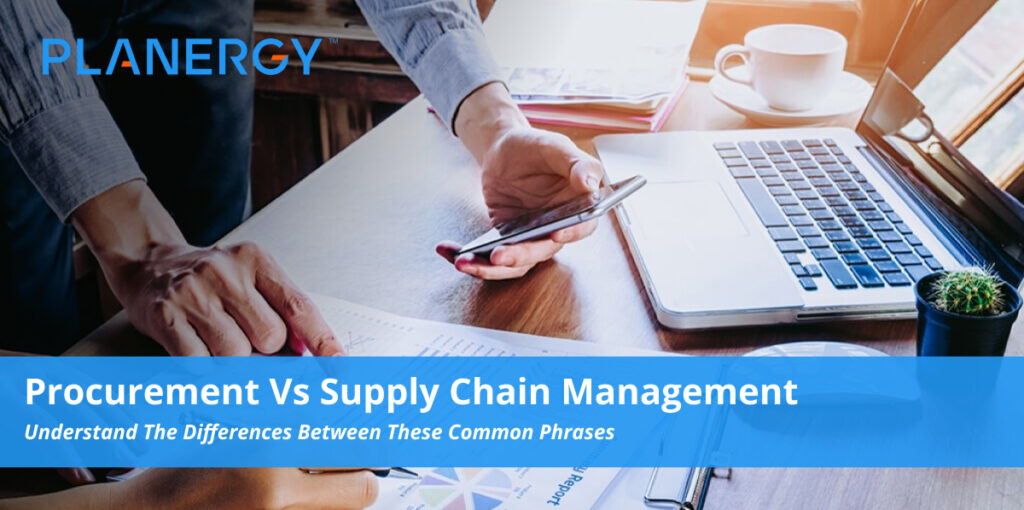In the purchasing world, it’s easy to use terms like supply chain management and procurement interchangeably. Most of us probably have at some point or another.
In reality, though the terms are related, they shouldn’t be used interchangeably because they don’t mean the same thing.
Understanding the difference between the two ensures you’ll use the right term when you need it.
What is Procurement?
Merriam-Webster Dictionary defines procure as, “to get possession of something: to obtain something by particular care and effort.”
As such, procurement is the process of getting possession or obtaining something. Expanding on that to include the business aspect, it is simply the act of “obtaining or buying goods and services.”
The procurement function includes preparing and processing a demand, all the way through receiving in stock rooms or wholesale warehouses and paying for the goods and services.
It involves several steps from planning the purchase and setting quality standards to supplier research and selection, value analysis, price negotiation and financing, and so on.
Procurement handles both direct and indirect costs. Direct costs are those required to manufacture or deliver the services you provide.
Indirect costs are associated with things you buy to run your business, such as your pens, pencils, office equipment, business cards, and so on. Those aren’t purchased for manufacturing your products but are still necessary for your operations.
Procurement processes are part of company strategy, because without the ability to purchase certain goods and services, operations may not be able to continue. If operations halt, even for a short period of time, profits could suffer considerably.
Procurement focuses on finding the right suppliers for the goods and services you need to manufacture your own products or deliver your own services.
It means maintaining standards of quality for your raw materials at an affordable price so you can continue to make a profit and keep your end customers happy.
It means knowing how you’re going to get those raw materials where they need to go, how you’re going to store extra inventory to keep operations running, and so on.
What is Supply Chain Management (SCM)?
SCM, according to Tech Target, “is the broad range of activities required to plan, control, and execute a product’s flow, from acquiring raw materials and production through distribution to the final customer, in the most streamlined and cost-effective way possible.”
Proper SCM covers the overall supply chain process and will create an efficient system that lowers costs, boosts profits, and promotes collaboration between all parts of the supply chain.
This includes identifying company needs, financing purchases, strategic sourcing, negotiating price, quality control, inventory control, managing of transportation companies during both receiving and sending, etc.
This follows right through until the product is in the hands of a customer. Companies with the right SCM strategy are better equipped to manage consumer demand, carry the right inventory for their needs, keep costs down, effectively handle any disruptions in the system, and keep things running smoothly.
Procurement is the process of getting the materials you need. The supply chain is the infrastructure you need to obtain those materials.
Differences Between Procurement and Supply Chain Management
If your company manufactures office furniture, then procurement is the process of sourcing the materials you need to build the furniture.
The supply chain is the entire process involved in producing and delivering the desk, chair, filing cabinet, or other piece of office furniture in your catalog to your customers.
Supply chain management is the process overseeing the entire supply chain to ensure you have everything you need to meet current demand.
Supply chains can be highly complex, but at the most basic level include:
- Raw material producer(s): Lumber yards, for instance, to supply the wood for building desks and other pieces of office furniture.
- Manufacturer: Your company – you build the various pieces of office furniture.
- Distributor: The companies you work with to get your office furniture to retail locations.
- Retailers: The retail locations that sell your office furniture.
- Customers: The people who purchase your office furniture from the retailers you work with.
The supply chain is the network of companies you work with to get your product into the hands of your customer. As such, you may also work with wholesalers who buy your products in bulk at a discount, and warehouses that will store inventory.
The complexity of your supply chain varies based on several factors, including your industry and product or service.
SCM involves effort to reduce or eliminate disruptions throughout the supply chain. Issues can arise anywhere. For instance, one of your saws could stop working, halting manufacturing until a new one is procured.
Transportation could halt due to bad weather in the region your logistics providers will travel through. Retailers could decide to stop carrying your products because their customers aren’t buying them.
Your raw material gatherers could increase their prices because of a shortage of material. All of these scenarios can have negative repercussions and could cause a significant issue for your company.
Essentially, procurement starts your supply chain, and stops when you have all the goods and services you need to complete the production of your products.
In the real world, production of your products is likely continuous, thus meaning your procurement efforts have to be as well.
Procurement and SCM software is available to handle all parts of the process. The software products aim to assist with planning for demand management, executing strategies for day-to-day operations, visibility to help anticipate and spot risks to proactively manage them instead of waiting for things to happen, inventory management, logistics management, and more.
With the complexities of both procurement and SCM, it’s easy to see why the terms are often used interchangeably, even though there are significant differences.




